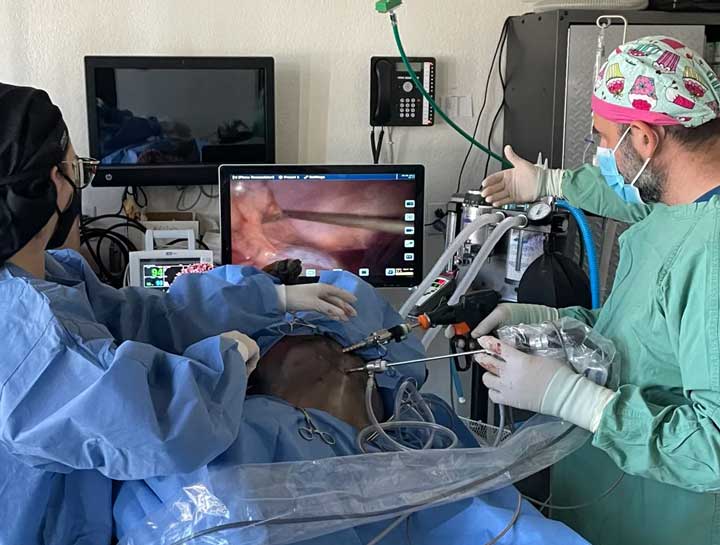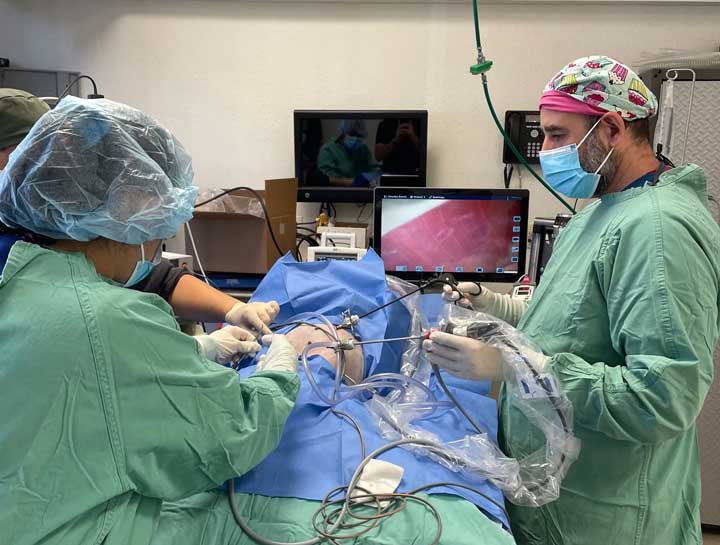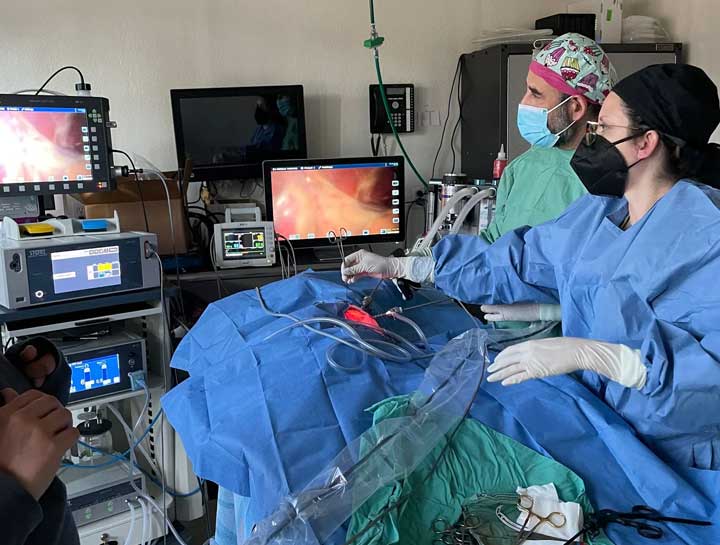Endoscopy
A minimally invasive imaging technique.
What is Endoscopy?
Veterinary endoscopy is a medical procedure used in veterinary medicine to diagnose and treat various conditions in animals. It involves the use of an endoscope, which is a thin, flexible tube with a light and camera at the tip. The endoscope is inserted into the body through a natural opening or a small incision to visualize and examine internal structures.
1. Gastrointestinal Endoscopy: Veterinarians use endoscopy to examine the gastrointestinal tract of animals, including the esophagus, stomach, and intestines. This can help diagnose conditions such as gastrointestinal bleeding, ulcers, foreign body ingestion, and inflammatory bowel disease.
2. Laparoscopy: Laparoscopic procedures involve the use of a small endoscope and instruments inserted through tiny incisions in the abdominal wall. It is used for procedures such as spaying and neutering, as well as diagnosing and treating conditions in the abdominal cavity.
3. Rhinoscopy: Rhinoscopy is the use of an endoscope to examine the nasal passages, sinuses, and associated structures. It is often used in cases of chronic nasal discharge or respiratory issues.
4. Otoscopy: Veterinarians use otoscopy to examine the ear canals and ear drums of animals, helping to diagnose and treat ear infections and other ear-related problems.'
5. Foreign-body retrieval and removal: Veterinary endoscopy offers several advantages, including minimally invasive procedures, reduced pain and recovery time for animals, and the ability to obtain visual information without the need for more invasive surgeries. It allows veterinarians to make accurate diagnoses and provide appropriate treatment for a wide range of conditions in animals.
Benefits of Endoscopy
Accurate Diagnosis
Endoscopy allows veterinarians to visually examine internal structures, providing a highly accurate and direct way to diagnose a wide range of diseases and conditions. It often leads to quicker and more precise diagnoses.
Treatment Options
In addition to diagnosis, endoscopy can be used for therapeutic purposes. It enables veterinarians to perform certain procedures, such as removing foreign bodies, taking biopsies, or treating bleeding ulcers, without the need for major surgery.
Reduced Risk
Because endoscopy is minimally invasive, it generally carries a lower risk of complications compared to open surgeries. This can be especially beneficial for older or high-risk animals.
Quicker Recovery
Because endoscopy is minimally invasive, it generally carries a lower risk of complications compared to open surgeries. This can be especially beneficial for older or high-risk animals.
Less Scarring
Because endoscopy is minimally invasive, it generally carries a lower risk of complications compared to open surgeries. This can be especially beneficial for older or high-risk animals.
Reduced Stress
Endoscopy can be less stressful for animals than open surgeries, as it typically involves shorter anesthesia times and less handling during the procedure.
Less Disruption to Tissues
Endoscopic procedures are less disruptive to the surrounding tissues, which can be crucial in delicate areas, such as the respiratory or gastrointestinal tract.
Early Detection & Customization
Endoscopy allows for the early detection of certain conditions, potentially leading to more effective treatment and improved outcomes. Endoscopic procedures can be tailored to the specific needs of the individual patient, making it a versatile tool in veterinary medicine.
What is the endoscopy procedure like?
The endoscopy procedure for dogs and cats is similar to the general process I described earlier. However, there are some specific considerations for these animals:
- Preparation: Before the procedure, the dog or cat is typically fasted for a specific period to ensure an empty stomach, especially for gastrointestinal endoscopy. Anesthesia is administered to keep the animal still and comfortable.
- Introduction of the Endoscope: The veterinarian inserts the endoscope into the animal's body through a natural opening or a small incision, depending on the specific procedure. For gastrointestinal endoscopy, the most common entry point is through the mouth.
- Visual Examination: The veterinarian carefully guides the endoscope through the body, allowing for the visualization of internal structures. They can manipulate the endoscope to inspect different areas and identify any abnormalities.
- Diagnostic and Treatment Procedures: Depending on the purpose of the endoscopy, the veterinarian may perform various diagnostic or therapeutic procedures. This can include taking biopsies for laboratory analysis, removing foreign objects, extracting samples from the respiratory tract, or treating certain conditions directly through the endoscope.
- Monitoring: Throughout the procedure, the veterinary team continuously monitors the animal's vital signs, including heart rate, respiration rate, and oxygen levels, to ensure the pet's safety and well-being.
- Conclusion: Once the veterinarian has completed the necessary examinations or treatments, they carefully remove the endoscope from the animal's body.
- Recovery: After the procedure, the dog or cat is allowed to recover from anesthesia in a quiet and comfortable area. Post-procedure care may include pain management, monitoring for any adverse reactions or complications, and gradually reintroducing food if fasting is necessary.
The experience of the endoscopy procedure for dogs and cats can vary depending on the individual animal's temperament, health, and the specific condition being investigated or treated. Most veterinary endoscopy procedures are minimally invasive, and with proper care and monitoring, pets tend to recover relatively quickly compared to traditional open surgeries. Veterinarians and their teams are trained to handle the procedure with care and to ensure the comfort and safety of the animal throughout the process.
Frequently Asked Questions
Is endoscopy painful for my pet?
No, endoscopy is not typically painful for pets. They are placed under anesthesia during the procedure to ensure they are comfortable and do not experience pain.
How long does an endoscopy procedure for dogs and cats usually take?
The duration of the procedure varies depending on the specific type of endoscopy and the areas being examined or treated. It can range from a few minutes to an hour or longer.
Will my pet have any restrictions or special care requirements after an endoscopy?
Your veterinarian will provide post-procedure care instructions. These may include temporary dietary restrictions, pain management, and monitoring for any signs of complications.
Are there any risks associated with endoscopy for pets?
While endoscopy is considered safe, like any medical procedure, there are some risks involved. These risks are typically low and include anesthesia-related complications, perforation (rare), or infection (very rare). Your veterinarian will discuss these risks with you.
Can endoscopy replace traditional surgery for my pet's condition?
Endoscopy is a minimally invasive option for certain conditions, but it cannot replace traditional surgery in all cases. Your veterinarian will determine the most appropriate approach based on your pet's specific condition and needs.
Is endoscopy covered by pet insurance?
It depends on your pet insurance policy. Some policies may cover endoscopic procedures, while others may have limitations or exclusions. It's essential to check with your insurance provider to understand your coverage.
Will my pet need follow-up appointments after an endoscopy?
Follow-up appointments may be necessary, depending on the findings of the endoscopy and the treatment plan. Your veterinarian will provide guidance on any necessary follow-up care.
What Kinds of Diseases Can Be Diagnosed With an Endoscopy?
Endoscopy can be a valuable diagnostic tool for dogs and cats, allowing veterinarians to visually examine and diagnose a wide range of diseases and conditions. Here are some common diseases and conditions in dogs and cats that can be diagnosed or evaluated using endoscopy:
1. Gastrointestinal Disorders:
- Inflammatory bowel disease (IBD)
- Gastrointestinal bleeding
- Gastric ulcers
- Gastrointestinal polyps
- Foreign body ingestion
- Esophageal strictures
2. Respiratory Disorders:
- Chronic cough or respiratory infections
- Nasal polyps
- Laryngeal and tracheal disorders
- Evaluation of lung and bronchial conditions
3. Urinary Tract Disorders:
- Bladder stones (cystoscopy)
- Urethral obstructions
- Urinary tract tumors
4. Ear and Ocular Conditions:
- Ear infections and otitis
- Evaluation of ear canals and eardrums
- Eye conditions (such as removal of foreign bodies)
5. Orthopedic and Soft Tissue Conditions:
- Joint disorders (arthroscopy)
- Soft tissue masses and tumors
- Evaluation of the inside of joints and ligaments
6. Reproductive Conditions:
- Evaluation of the reproductive tract
- Assessing fertility issues
- Diagnosis and treatment of certain reproductive disorders
7. Other Conditions:
- Diagnosis and staging of certain cancers
- Assessment of gastrointestinal bleeding sources
- Evaluation of chronic vomiting or diarrhea
In addition to diagnosis, endoscopy can also be used for therapeutic purposes, such as the removal of foreign bodies, polyp removal, and the treatment of bleeding ulcers. It is a minimally invasive procedure that often allows for quicker recovery times and less post-operative discomfort compared to traditional open surgeries.
It's important to note that the specific conditions that can be diagnosed or treated with endoscopy may vary depending on the equipment and expertise available at the veterinary facility. Veterinarians will determine the most appropriate diagnostic or therapeutic approach based on the individual patient's symptoms and medical history.
Call us at (626) 568-1115 to learn more about our endoscopy services.



